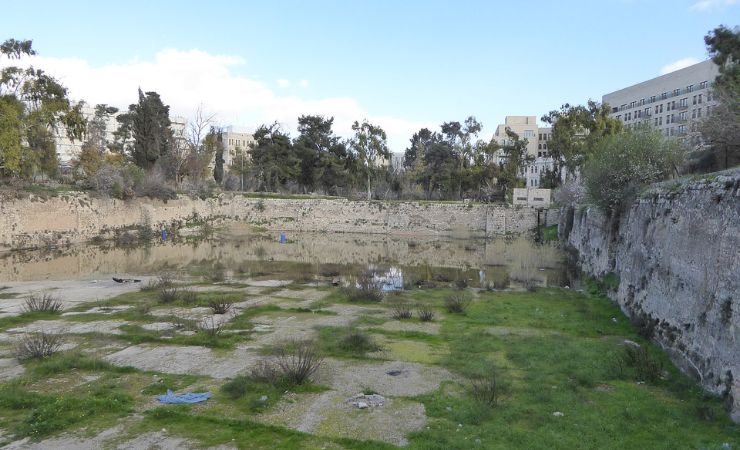Ancient Waters: The Story of Mamilla Pool
Discover the intriguing history and significance of the Mamilla Pool, an ancient reservoir in Jerusalem. Once a crucial water source for the city, it now stands amid the Mamilla Cemetery, consisting of notable graves from the Mamluk period. Among those interred here are Kebekiyeh dia A-Din Aidughdi, a Mamluk governor, and members of the influential Dajani family.

Mamilla Pool Location
The Mamilla Pool is located outside the Old City walls of Jerusalem, approximately 650 meters northwest of Jaffa Gate, and proximal to the New Gate and the Waldort Astoria Hotel. It is situated at the center of the Mamilla Cemetery.
The Source of the Name "Mamilla"
The origin of the name “Mamilla” has several intriguing theories. One suggests it derives from the Hebrew word ‘m’malle’, meaning ‘the filler’, reflecting its function as a reservoir. Another theory posits that it comes from the Arabic phrase “مأمن الله” (Ma’man Allah), meaning “from God” or “place of safety provided by God.” Additionally, it might be named after a sponsor, possibly a person named Mamilla or Maximilla, or a nearby church dedicated to Saint Mamilla or Babila



The Site's History
The Mamilla Pool has a rich and multifaceted history, dating back to ancient times. Initially, it served as a crucial water reservoir for the city of Jerusalem. Evidence suggests that it was a significant part of Jerusalem’s water system during the Byzantine period, primarily serving the baths located near Jaffa Gate. This large pool, known as the Upper Pool of Gihon during the Roman and Byzantine eras, played a vital role in the city’s water supply and hygiene systems.
During the Crusader period, the pool was referred to as Patriarch’s Lake, feeding the Pool of the Patriarch’s Bath within the city walls. This name change reflects the shifts in control and cultural influences in Jerusalem over the centuries. In the 19th century, travelers like Horatio Balch Hackett described the pool as a functional reservoir, emphasizing its continued importance for local residents who used its steps to fetch water and bathe their animals.
The 20th century brought significant changes to the Mamilla Pool. Post-1948, there were attempts to integrate it into the modern water supply system. However, these efforts were short-lived, and the pool eventually fell into disuse. Despite its decline, the pool has remained a focal point for archaeological and historical studies, revealing insights into Jerusalem’s ancient water management systems.

The Pool's Dimensions and Archaeological Findings
The Mamilla Pool measures approximately 291 feet in length, 192 feet in width, and 19 feet in depth, with steps at two corners that allowed people to descend and fetch water or lead animals to drink. The pool features a sophisticated drainage system, initially 53 cm in diameter, reducing to 23 cm, which allowed for precise water regulation. Archaeological evidence shows that the pool was part of the water system supporting the Byzantine baths near the Jaffa Gate. In addition to its historical features, seasonal rains transform the pool into a habitat for crabs, frogs, and migratory birds, highlighting its ecological importance. A notable feature from the British Mandate period is a Caterpillar pump located near the pool, which underscores the site’s ongoing role in water management and supply through various historical periods.
Sources and Additional Information
Nearby Sites
- Waldorf Astoria Hotel: Located near the Mamilla Cemetery. Was once the Palace Hotel, a location rich with historical significance.
- Museum of Tolerance: A modern museum showcasing the region’s historical layers.
- YMCA Building: This historic building features beautiful architecture and offers a variety of cultural and recreational activities.
- Tower of David: An ancient citadel offers a museum that presents the history of Jerusalem through exhibitions and stunning views of the city.



